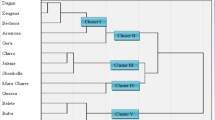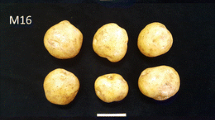Abstract
Field and laboratory studies were conducted in 1985–1986 to evaluate the relative severity ofRhizoctonia solani damage among 26 clones and five potato (Solanum tuberosum) cultivars. A test with true potato seeds showed that resistance toR. solani could be identified in two years. One highly resistant line was identified by this method. Moderate degrees of resistance were found in lines from the USDA Potato Breeding Program (BARC) with russet types producing a higher percentage of highly resistant lines than round whites. A laboratory test revealed that apical sprout damage (nipping) was variable within and between lines and that it was an important phase of disease development to measure when determining resistance because of its effects on the resulting plant growth and production of marketable tubers. It was also determined that to accurately define resistance toR. solani in potato, all phases of the disease must be evaluated to insure against resistance “breakdown” at some point in plant development.
Compendio
En 1985–1986, se condujeron estudios de campo y laboratorio para evaluar la severidad relativa de los daños por Rhizoctmia solani entre 26 clones y cinco cultivares de papa (Solarium tuberosum). Un examen con semillas sexuales de papa demostró que la resistencia a R. solani podía ser identificada en dos años. Una línea de alta resistencia fue identificada por este método. Se encontraron grados moderados de resistencia en líneas del Programa de Mejoramiento de Papa (BARC) del USDA. Los tipos moreno-rojizos produjeron un mayor porcentaje de líneas altamente resistentes que las blanco-redondos. Un examen de laboratorio reveló que el daño del brote apical (nipping) fue variable dentro y entre líneas y que era una fase importante del desarrollo de la enfermedad a medir al determinar la resistencia, debido a los efectos resultantes sobre el crecimiento de la planta y la producción de tubérculos comerciables. También se determinó que para definir con precisión la resistencia de la papa al R. solani, todas las fases de la enfermedad deben de ser evaluadas para asegurarse contra la “pérdida” de la resistencia en algún momento del desarrollo de la planta.
Similar content being viewed by others
Literature Cited
Anonymous. 1986. List of potato varieties in Canada. 111 pp. New Brunswick Department of Agriculture. Perth-Andover, N.B. Canada.
Bateman D.F. 1970. Pathogenesis and disease. Pages 161–171.In: Rhizoctonia solani, biology and pathology, Ed. by J.R. Parmeter, Jr. Univ of Calif Press. Berkeley, Calif.
Buritica, P. and J. Velandia 1977. A method for selection of potato seed for resistance toRhizoctonia solani Kuhn. F Topatologia Colombiana 6:49–56.
Carling, D.E. 1984. Rhizoctonia disease of potato. Agroborealis July:25-28.
Chand, T. and C. Logan 1982. Reaction of ten potato cultivars to stem canker and black scurf of potato caused byRhizoctonia solani. Ann Appl Biol Supp 100:102–103.
Davis, J.R. and M.D. Groskopp 1979. Influences of theRhizoctonia solani disease on production of the Russet Burbank potato yield and size differences. Am Potato J 56:253–264.
Dijist, G., A. Bouman, A. Mulder and J. Roosjen. 1986. Effect of haulm destruction supplemented by cutting off roots on the incidence of black scurf and skin damage flexibility of harvest period and yield of seed potatoes in field experiments. Netherlands J Plant Pathology 92:287–303.
Gudmestad, N.C., J.E. Huguelet and R.T. Zink 1978. The effect of cultural practices and straw incorporation into the soil on Rhizoctonia disease of potato. Plant Dis Rep 62:985–989.
Gudmestad, N.C., R.T. Zink and J.E. Huguelet 1979. The effect of harvest date and tuber-borne sclerotia on the severity ofRhizoctonia disease of potato. Am Potato J 56:35–41.
Henis, Y., A. Ghaffer, R. Baker and S.L. Gillespie 1978. A new pellet soil sampler and its use for the study of population dynamics ofRhizoctonia solani in soil. Phytopathology 68:371–376.
Hide, G.A., J.M. Hirst and O.J. Stedman 1973. Effects of blackscurf (Rhizoctonia solani) on potatoes. Ann Appl Biol 74:139–148.
Leach, L.D. and R.H. Garber. 1970. Control of Rhizoctonia. Pages 189–198. In:Rhizoctonia solani, biology and pathology. Ed. by J.R. Parmeter, Jr. Univ of Calif Press. Berkeley, Calif.
Leach, S.D. and C.W. Murdoch. 1985. Evaluation of Thiabendazole and Pentachloronitrobenzene for control of the Rhizoctonia Disease Complex of white potato (Solanum tuberosum L.) Am Potato J 62:459–469.
Maksimor, V.M. 1981. Prospects of breeding potatoes for resistance toRhizoctonia. Referativnyi Zhurnal 400:92–95.
Morse, W.J. and M. Shapovalo. 1913. The rhizoctonia disease of potato. Maine Agri Expt Sta Bull 230:193–217.
Osipova, E.A. and L.P. Mikhewa. 1976. Resistance toRhizoctonia in seedlings of diploid cultivated species of potato after artificial infection. Referativnyi Zhurnal 208:179–183.
Pietkiewicz, J.B. 1980. Variation in the reaction of potato tubers to disease. Potato Res 23:473 (abst).
Rolfs, F.M. 1902. Potato failures. A preliminary report. Colo Agri Expt Sta Bull 70:1–12.
Small, T. 1945. Black scurf and stem canker of potato (Corticium solani Bound. & Galz.) Further studies on the use of clean seed and contaminated seed potatoes and on the contamination of crop tubers. Ann Appl Biol 32:206–209.
Spencer, D. and R.A. Fox 1978. Assessment of pathogenicity ofRhizoctonia solani Kuhn to some potato tissues and to cereals. Potato Res 21:81–88.
— 1978. The distribution of sclerotia ofRhizoctonia solani Kuhn scab on the surface of the potato tuber. Potato Res 21:291–300.
— 1979. The development ofRhizoctonia solani Kuhn on the underground parts of the potato plant. Potato Res 22:29–39.
— 1979. Post harvest development ofRhizoctonia solani Kuhn on potato tubers. Potato Res 22:41–47.
Stevenson, F.J. 1956. Breeding varieties of potato resistant to disease and insect injuries. Am Potato J 33:37–46.
Weinhold, A.R. and T. Bowman 1982. Rhizoctonia disease of potato: Effect on yield and control by seed treatment. Plant Disease 66:814–818.
Author information
Authors and Affiliations
Additional information
Deceased.
Mention of brand or firm names does not constitute an endorsement by the U. S. Department of Agriculture over others of a similar nature not mentioned.
Rights and permissions
About this article
Cite this article
Leach, S.S., Webb, R.E. Evaluation of potato cultivars, clones and a true seed population for resistance toRhizoctonia solani . American Potato Journal 70, 317–328 (1993). https://doi.org/10.1007/BF02851425
Accepted:
Issue Date:
DOI: https://doi.org/10.1007/BF02851425




